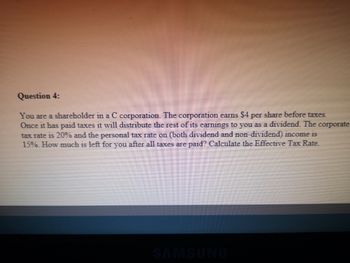
FINANCIAL ACCOUNTING
10th Edition
ISBN: 9781259964947
Author: Libby
Publisher: MCG
expand_more
expand_more
format_list_bulleted
Question

Transcribed Image Text:Question 4:
You are a shareholder in a C corporation. The corporation earns $4 per share before taxes.
Once it has paid taxes it will distribute the rest of its earnings to you as a dividend. The corporate
tax rate is 20% and the personal tax rate on (both dividend and non-dividend) income is
15%. How much is left for you after all taxes are paid? Calculate the Effective Tax Rate.
SAMSUNG
Expert Solution
This question has been solved!
Explore an expertly crafted, step-by-step solution for a thorough understanding of key concepts.
Step by stepSolved in 2 steps

Knowledge Booster
Learn more about
Need a deep-dive on the concept behind this application? Look no further. Learn more about this topic, accounting and related others by exploring similar questions and additional content below.Similar questions
- a. What is the relative tax advantage of corporate debt if the corporate tax rate is TC=0.22, the personal tax rate on interest is TpD=0.37, but all equity income is received as capital gains and escapes tax entirely ( TpE=0 )? b. How does the relative tax advantage change if the company decides to pay out all equity income as cash dividends that are taxed at 10% ? Note: Do not round intermediate calculations. Round your answers to 4 decimal places.arrow_forwardHello, This question is for corporate finance. I'm not sure how to solve this and what are the steps to solving these types of questions? Thanksarrow_forwardMy problem with questionarrow_forward
- You are a shareholder in an S corporation. The corporation earns $1.67 per share before taxes. As a pass through entity, you will receive $1.67 for each share that you own. Your marginal tax rate is 20%. How much per share is left for you after all taxes are paid? Amount that remains is $ per share. (Round to the nearest cent.)arrow_forwardAa 126.arrow_forward1arrow_forward
- Suppose you are in the 33% income tax bracket. You own shares in Carefree Casinos, whose profits are taxed at a 25% rate. “Double taxation” means: A. Carefree pays 25% tax on before-tax profits, then another 25% tax is applied to its after-tax profits. B. Carefree pays 25% tax on its before-tax profits, then another 33% tax is applied to its after-tax profits. C. Carefree pays 25% tax on before-tax profit and 33% on its retained earnings, and you pay 33% tax on dividends which are distributed to you. D. Carefree pays 25% tax on before-tax profit but 0 tax on its retained earnings, and you pay 33% tax on dividends which are distributed to you. E. Carefree pays 25% tax on before-tax profit and 25% on its retained earnings, and you pay 33% tax on dividends which are distributed to you.arrow_forwardDividends received from a domestic corporation 50,000 Dividends received from a resident foreign corporation 40,000 Dividends received from a non-resident foreign corp 30,000 • The domestic corporation is doing 40% of its business outside the Philippines. • The resident foreign corporation has been doing 60% of its business in the Philippines. • The taxpayer is a resident citizen How much dividend income is taxable? . How much is the final tax on his dividend income? Assuming taxpayer is domestic corporation, how much dividend income is taxable?arrow_forwardPlease help mearrow_forward
- Required: Find the after-tax return to a corporation that buys a share of preferred stock at $40, sells it at year-end at $40, and receives a $4 year-end dividend. The firm is in the 21% tax bracket. (Round your answer to 2 decimal places.) After-tax rate of return %arrow_forwardYou are a shareholder in an S corporation. The corporation earns $2.36 per share before taxes. As a pass through entity, you will receive $2.36 for each share that you own. Your marginal tax rate is 20%. How much per share is left for you after all taxes are paid? The amount that remains is how much per share. (Round to the nearest cent.)arrow_forwardd. Determine what rate of return must be earned on the net proceeds to the corporation so there will not be a dilution in earnings per share during the year of going public. Note: Do not round intermediate calculations. Enter your answer as a percent rounded to 2 decimal places. > Answer is complete but not entirely correct. Rate of return 27.74 % e. Determine what rate of return must be earned on the proceeds to the corporation so there will be a 5 percent increase in earnings per share during the year of going public. Note: Do not round intermediate calculations. Enter your answer as a percent rounded to 2 decimal places. > Answer is complete but not entirely correct. Rate of return 11.42%arrow_forward
arrow_back_ios
arrow_forward_ios
Recommended textbooks for you

 AccountingAccountingISBN:9781337272094Author:WARREN, Carl S., Reeve, James M., Duchac, Jonathan E.Publisher:Cengage Learning,
AccountingAccountingISBN:9781337272094Author:WARREN, Carl S., Reeve, James M., Duchac, Jonathan E.Publisher:Cengage Learning, Accounting Information SystemsAccountingISBN:9781337619202Author:Hall, James A.Publisher:Cengage Learning,
Accounting Information SystemsAccountingISBN:9781337619202Author:Hall, James A.Publisher:Cengage Learning, Horngren's Cost Accounting: A Managerial Emphasis...AccountingISBN:9780134475585Author:Srikant M. Datar, Madhav V. RajanPublisher:PEARSON
Horngren's Cost Accounting: A Managerial Emphasis...AccountingISBN:9780134475585Author:Srikant M. Datar, Madhav V. RajanPublisher:PEARSON Intermediate AccountingAccountingISBN:9781259722660Author:J. David Spiceland, Mark W. Nelson, Wayne M ThomasPublisher:McGraw-Hill Education
Intermediate AccountingAccountingISBN:9781259722660Author:J. David Spiceland, Mark W. Nelson, Wayne M ThomasPublisher:McGraw-Hill Education Financial and Managerial AccountingAccountingISBN:9781259726705Author:John J Wild, Ken W. Shaw, Barbara Chiappetta Fundamental Accounting PrinciplesPublisher:McGraw-Hill Education
Financial and Managerial AccountingAccountingISBN:9781259726705Author:John J Wild, Ken W. Shaw, Barbara Chiappetta Fundamental Accounting PrinciplesPublisher:McGraw-Hill Education


Accounting
Accounting
ISBN:9781337272094
Author:WARREN, Carl S., Reeve, James M., Duchac, Jonathan E.
Publisher:Cengage Learning,

Accounting Information Systems
Accounting
ISBN:9781337619202
Author:Hall, James A.
Publisher:Cengage Learning,

Horngren's Cost Accounting: A Managerial Emphasis...
Accounting
ISBN:9780134475585
Author:Srikant M. Datar, Madhav V. Rajan
Publisher:PEARSON

Intermediate Accounting
Accounting
ISBN:9781259722660
Author:J. David Spiceland, Mark W. Nelson, Wayne M Thomas
Publisher:McGraw-Hill Education

Financial and Managerial Accounting
Accounting
ISBN:9781259726705
Author:John J Wild, Ken W. Shaw, Barbara Chiappetta Fundamental Accounting Principles
Publisher:McGraw-Hill Education